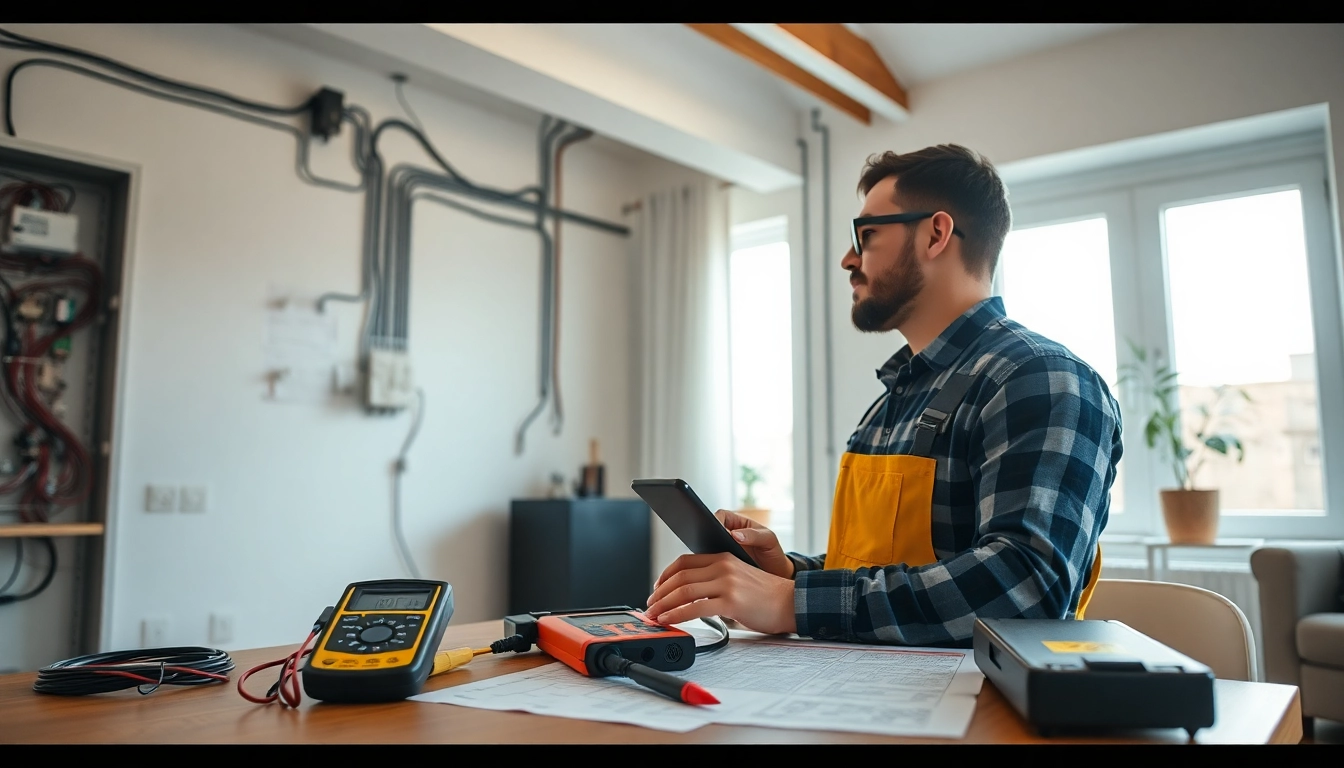Understanding EICR Inspections
What is an EICR Inspection?
An Electrical Installation Condition Report (EICR) inspection is a comprehensive examination of the electrical wiring and equipment in a property to ensure safety and compliance with the current regulations. Conducted by qualified electricians, EICR inspections involve testing and assessing the condition of the electrical installations against established safety standards. This report is vital for both residential and commercial properties, as it determines whether the electrical installations pose any safety risks.
The aim of an EICR is to identify any areas that require corrective actions. This could involve anything from minor repairs to significant upgrades or even complete rewiring. By understanding the condition of the electrical systems in a property, owners can take the necessary steps to mitigate hazards and maintain compliance with local laws. For more information about EICR inspections and their importance, you may visit EICR Inspections.
Importance of EICR Inspections for Properties
The significance of EICR inspections cannot be overstated. With electrical systems being a primary cause of property damage through fires or electrical shocks, regular inspections are crucial for ensuring safety. Here are some critical reasons why EICR inspections are essential:
- Enhancing Safety: Regular EICR inspections help to identify and rectify faults that could cause electric shocks or fires, protecting occupants and their property.
- Legal Compliance: Many regions mandate EICR inspections, particularly for rental properties. Non-compliance can lead to legal ramifications and hefty fines.
- Insurance Requirements: Insurance companies often require proof of recent safety inspections before they provide coverage or pay claims related to electrical failures.
- Preventative Maintenance: By identifying issues before they escalate into hazards, property owners can save on costly repairs and replacements.
Common Misconceptions About EICR Inspections
Despite the clear benefits, there are several misconceptions about EICR inspections:
- Only for Rentals: Many believe EICR inspections are only necessary for rental properties. However, any property can benefit from regular inspections to ensure safety.
- Only Required When Selling: While EICR inspections can enhance property value when selling, they are necessary for ongoing safety and maintenance regardless of sale status.
- It’s Just a Formality: Some treat EICR inspections as mere paperwork, not recognizing the serious implications of undetected electrical faults.
Legal Requirements for EICR Inspections
Who Needs an EICR Inspection?
Legal requirements for EICR inspections often vary by location and property type. Typically, the following categories must comply with EICR regulations:
- Landlords: Many jurisdictions require landlords to obtain an EICR at least every five years to ensure rented properties remain safe.
- Commercial Properties: Businesses must conduct EICR inspections to comply with health and safety regulations and uphold employee safety.
- Homeowners: While not legally required, homeowners are strongly encouraged to conduct EICR inspections periodically for safety and insurance purposes.
Frequency of EICR Inspections for Properties
The recommended frequency of EICR inspections can depend on various factors, such as property type and usage. Common guidelines suggest:
- Residential Properties: Every ten years, or every five years for rentals.
- Commercial Properties: Every three to five years, or more frequently if the property has high electrical usage.
- Specialized Installations: Properties with specific or high-risk electrical systems should be inspected annually or bi-annually.
Consequences of Not Complying with EICR Regulations
Failing to comply with EICR regulations can result in serious consequences:
- Legal Penalties: Landlords may face legal action or heavy fines if they do not meet the EICR inspection requirements.
- Increased Insurance Premiums: Insurance companies may raise premiums or deny claims related to electrical faults if there’s no recent EICR.
- Safety Risks: Ignoring the need for inspections increases the likelihood of electrical hazards, putting tenants and properties at risk.
Preparing for an EICR Inspection
What to Expect During an EICR Inspection
Understanding what happens during an EICR inspection can help property owners prepare. Here’s an overview of the typical inspection process:
- Visual Inspection: The inspector will first visually assess the property, checking for any obvious signs of wear or damage.
- Testing: A series of tests will be conducted on the wiring and electrical installations to evaluate their integrity and safety.
- Report Generation: Following the inspection, the inspector will compile findings in an EICR report, detailing any issues and required actions.
Essential Preparations for Property Owners
To ensure a smooth inspection process, property owners should take the following steps:
- Select a Qualified Inspector: Ensure the inspector is certified and experienced in electrical systems.
- Clean and Clear Areas: Clear access to electrical panels, sockets, and outlets for easier inspection.
- Compile Documentation: Prepare any existing electrical certificates or previous EICR reports to provide context to the inspector.
Common Issues Found in EICR Inspections
During EICR inspections, various issues may arise, including:
- Faulty Wiring: Damaged or outdated wiring can present serious safety risks.
- Insufficient Earthing: Poor earthing can increase the risk of shock hazards.
- Outdated Electrical Equipment: Equipment not compliant with the current regulations often requires upgrades or replacement.
Conducting an EICR Inspection: Best Practices
Choosing a Qualified Inspector for EICR
Selecting a competent inspector is vital for ensuring a thorough and accurate EICR. Here are some tips for choosing the right professional:
- Qualifications: Ensure the inspector holds relevant qualifications and is registered with an appropriate regulatory body.
- Experience: Look for professionals with experience in EICR inspections and a clean track record of previous work.
- References: Check for reviews or references from previous clients to gauge reliability and professionalism.
Understanding the EICR Report and Its Findings
Once the inspection is complete, property owners will receive an EICR report that includes:
- Overall Rating: Reports will indicate whether the installation is ‘satisfactory’ or ‘unsatisfactory’.
- Observations: Detailed notes on any defects or concerns found during the inspection.
- Recommendations: Suggested actions to rectify any identified issues, along with timelines for completion.
Actions to Take After an EICR Inspection
Following an EICR inspection, property owners should take immediate action on recommendations to maintain safety:
- Address Urgent Issues: Take immediate steps to rectify any serious safety concerns identified in the report.
- Plan for Upgrades: Consider investing in upgrades or improvements as suggested to future-proof the property.
- Document Changes: Maintain records of any work carried out in response to the EICR for future reference and inspections.
Future Trends and Innovations in EICR Inspections
Technological Advances in Electrical Safety Inspections
As technology evolves, EICR inspections are becoming more sophisticated. Innovations such as thermal imaging and advanced testing devices are enhancing the inspection process:
- Thermal Imaging: This technology allows inspectors to identify hotspots and potential electrical failures without invasive testing.
- Smart Testing Equipment: Digital multimeters and portable RCD testers enhance accuracy and efficiency during inspections.
- Data Management Software: Software that automates reporting and tracks maintenance history improves the overall experience for property owners.
The Impact of Smart Technologies on EICR Inspections
Smart technologies are revolutionizing how EICR inspections are conducted:
- Smart Meters: These devices allow for real-time monitoring and can alert property owners to potential issues.
- IoT Devices: Integrated systems can provide ongoing assessments and predictive analytics for electrical systems.
- Remote Inspections: Advancements in remote monitoring allow for ongoing safety assessments without the need for frequent inspector visits.
Preparing for Future Compliance Requirements
As regulations evolve, staying informed about compliance requirements is crucial for property owners. It’s recommended to:
- Stay Educated: Keep abreast of changes to local and national electrical safety regulations.
- Conduct Regular Reviews: Evaluate electrical installations regularly, ahead of mandatory inspections.
- Engage Professionals: Work with qualified electrical professionals to ensure ongoing compliance and safety.



